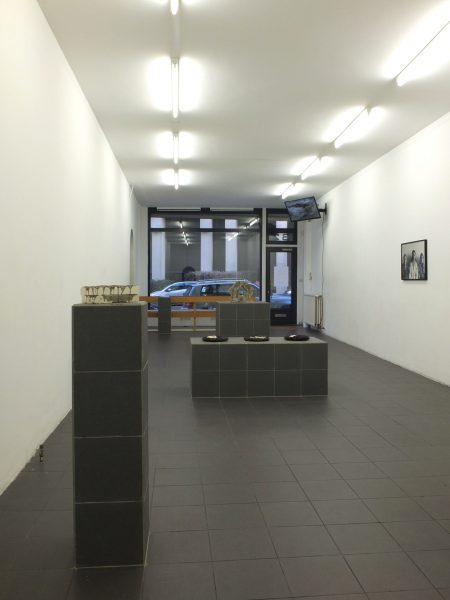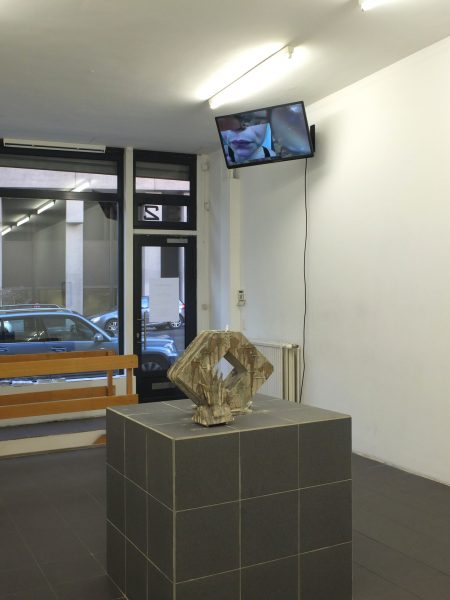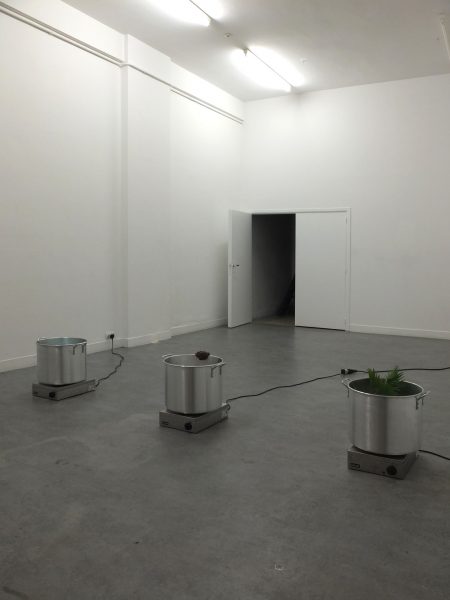OPENING
WEDNESSDAY 10.09.14 AT 7PM
EXHIBITION
11.09.14 – 24.10.14
“Overall, the exhibition Elusive Earths ruminates on processes of ingestion, whether metaphorical, physical, or imaginary. We can say it is a continuation of my work on mud and on the intake of soil and the earth, formulating a kind of language or writing horizon. This research regards what I call the naked rudeness of a moral economy of the land—what it is like to devour the earth’s problems and contents in one whole and spit them out again—whether through effects of inner transformation, metamorphosis, the breeding of selves and bodies, metabolics, body-branding, or shapeshifting, etc.
The exhibition’s point of departure is terra sigillata (sealed earth), earth “pills” from Greece’s antiquity that one could attribute to the first lineage of pharmacology, and clearly involved an implicit performativity in their preparation. Thus, the show involves a research process of sourcing these tablets and related tools in the origins of pharmacology, involving them in different forms of replication, extraction and multiplication, and carrying out a journey to the Aegean sea to source an ancient earth fountain that is elusive and clearly not easily locatable or visible.
Indeed other things and earths were sourced. Yet the discovery relied on making parallels with ancient edible clays to the crying needs of modern pharmacology and the rare earth industry today. For example, Greece is currently carrying out heavy exploration of new earths as a way to liberate themselves from their current crisis. A delicate balance of disorder and healthiness? Or a perpetuation of nature and man’s interconnected dependency?
Many works in the show take these narratives and material samples as starting points for a creative process. The sourced earths have become sealers or agents, subjects for advertising, or metaphors for self-multiplication or memory portals. Jean-Marie Appriou, Lorenzo Cirrincione, Ajay Kurian, and Georgia Sagri have each created specific commissions for the exhibition while the other artists have created new amendments and adaptations to existing works. The upper floor seeks to “seal” the exhibition or “contain” the writing of the exhibition and its processes, while the lower floor constitutes the stomach/brain where all bubbles and pervades. I picture this show as an experiment in the making, leaning on the notion of the “experimenter’s regress”– a loop of dependence between theory and evidence. The “research frontier” where the outcome of research is uncertain, because we are dealing with “novel phenomena.”
A psycho-pharmaceutical thriller written by Scottish writer James Clegg is key in taking it up a notch and extending the narrative to placebos. In October, Arthur Macgregor, leading scholar and long time curator in the Department of Antiquities at the Ashmolean Museum in Oxford, will deliver a lecture on the legacy and elusiveness of these tablets and clay narratives at large. Further texts by Ajay Kurian, an artist in the exhibition, as well as French scholar Muriel Pardon-Labonnelie join to form a reader for the show. The idea is that texts will enter across the exhibition forming a kind of meta-narrative evolving towards the finissage.”
Jennifer Teets, Paris, August 2014
Texts by James Clegg, Ajay Kurian in conversation with Corin Hewitt, Muriel Pardon-Labonnelie, Arthur Macgregor and Jennifer Teets.
Curatorial Assistance: Elena Poughia
With thanks to:
Dr. George Migiros/Agricultural University of Athens Laboratory of Mineralogy & Geology, Dr. Effie Photos-Jones, Archeological Scientist, Spyros Tzintzos / S&B – Melos, Manousos Kantsos / Milos Mining Museum, Despoteri Katerina – Lemnos, Alexander Kiziriadis, Mr. Papasotiriou, Vasilis Charalabidis, Ministry of Culture – Lithuania, Anaïs Van der Stichelen, Musées royaux d’Art et d’Histoire, Bruxelles: Clair Massart, Florence Carlier, Anna Van Waeg, Fablab Brussels
A special thanks to Lorenzo Cirrincione

















